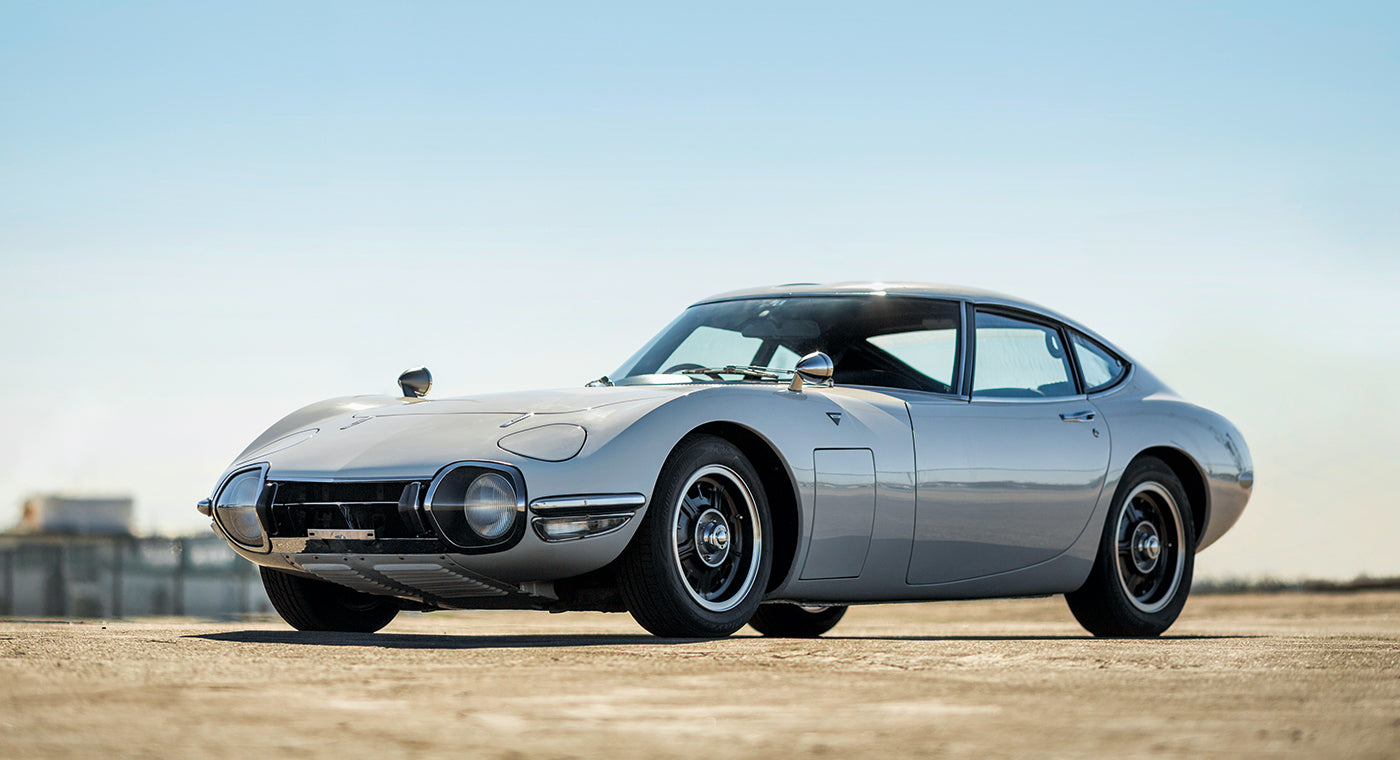
How Japan’s First Sports Car Became A Sean Connery Classic
A rare and perfect reflection of postwar optimism, Toyota’s first attempt is one for the history books
What makes a car valuable? Is it where its origin lies, reflected in the faces of those who built it? The Toyota 2000GT Coupe arose from a nation whose “Made in Japan” label was, at the time, the punch line of a joke. Is it in a car’s technical achievements? The 2000GT’s inline-six engine, as well as independent suspension, disc brakes, rack-and-pinion steering, were then-exotic features we take for granted today. Is it within the stories it accumulates along the way? The 2000GT starred alongside Sean Connery’s James Bond while being campaigned by racing legend Carroll Shelby in the United States.
Or is it the impact it has upon its introduction—the first evidence of an entire nation’s industrial might? Twenty years out from the ravages of World War II, Japan had developed the high-speed Shinkansen train, hosted the Summer Olympics, and blossomed into the second-largest economy in the world—by these lofty achievements, Japan’s first supercar was the icing on the cake.
The 2000GT was a shot in the dark, a triumph of optimism
Or is it simply how it looks? To that end, the 2000GT speaks volume. Perhaps, as a result, the rare, beautiful, and groundbreaking Toyota gained an enviable reputation for becoming the first Japanese car to sell at auction for over one million dollars. Finally, speculators mused, Japanese vehicles were worth collecting. But the 2000GT had always been more than the sound of a falling hammer.
By 1963, in the first-ever running of the Japanese Grand Prix, the manufacturer had triumphantly swept every class it entered. But the next year, Toyota saw its racing victories toppled by rival carmaker Prince and its Skyline. Its factory racing manager Jiro Kawano vowed to bring the brand back to racing glory the only way he knew how: with a high-end sports car, operating at the highest echelons of motorsport.

The 2000GT Coupe took just eight months to bring from sketch to running prototype. Designed by Satoru Nozaki, the car was only in production between 1967-70. At a top speed of 135 mph and retail price of $6,800 (roughly $53,000 today), the model quickly became a collectors favorite. (Photo: Patrick Ernzen, Beautiful Machines)
So, he assembled a secret team of engineers who joined him for what would be known as Project 280A. Industrial designer Satoru Nozaki reportedly sought a Japanese interpretation of the Jaguar E-Type. The team also studied the Lotus Elan and the new Porsche 911 while drawing from their own experiences building the Sports 800—a diminutive little thing that was Toyota’s first sports car in 1962.
And then they found an ally in Yamaha, makers of musical instruments and motorcycles, which had been developing a sports car with Nissan for some time—but the deal fell through. Stuck with the remnants of a half-finished prototype, Yamaha was all too happy to partner. Yamaha further developed an engine, adding dual overhead cams to a 2.0-liter inline-six derived from their Crown model. The result was a 150 horsepower show stopper. The prototype took just five months to assemble, a breakneck pace in the automotive industry. On October 29th, 1965, at Harumi Fairgrounds, the 2000GT was unveiled to an assembled international media. It also debuted alongside the 2000GT that day was the first-ever Corolla.
The 2000GT drove its way into pop-culture legend in the James Bond movie You Only Live Twice, first with Bond girl Akiko Wakabayashi, then with Sean Connery behind the wheel
The crowds were amazed. Here was a production Toyota that offered a limited-slip differential, disc brakes at all four corners, fully independent suspension, and a one-piece rosewood dashboard with the same finishing and woodwork as Yamaha's grand pianos. In attempting to emulate the E-Type, Nozaki had gone even further: he had imbued the car with compound curves across nearly every surface, extracting a lithe, stretched form that looked even more compact and dramatic than its British forebear. The body was hand-formed aluminum, beaten with hammers over wooden bucks at a brand-new factory that Yamaha had just opened. When it debuted, the 2000GT cost more than a Porsche 911 or an E-Type, and was six times as much as a Toyota Corolla. It also took longer to produce than all of them.
The moment the 2000GT began production, the markers decided to enter it in the Sports Car Club of America’s championships, facing the very cars that inspired it from Porsche, Lotus, and even national rivals like Datsun. Carroll Shelby made a deal with Toyota to field the cars only a year after he had famously lead Ford to beat Ferrari at Le Mans. No wonder Toyota entrusted him—supplying three cars and a slew of factory engineers for the war effort. But against the 911s and Corvettes of the world, the 2000GT never made enough horsepower to topple the ruling factions, which ultimately paved the way for its withdrawal.

Yamaha, which manufactures everything from motorcycles to musical instruments, gave the 2000GT’s sumptuous wood dashboard the full piano treatment. (Photo: Patrick Ernzen, Beautiful Machines)
Instead, the 2000GT drove its way into pop-culture legend in the James Bond movie You Only Live Twice, first with Bond girl Akiko Wakabayashi, then with Sean Connery behind the wheel, who at 6-foot-2 could barely fit in the cramped conditions. This paved the way for two convertibles in the near future. Next to the Shelby race cars, they are the rarest ones yet.
Though that isn’t saying much. With grand ambitions and a hefty price, Toyota built just 351 examples of the 2000GT. Nowadays, the brand can go ahead and build any sports car it wants—but the 2000GT was a shot in the dark, a triumph of optimism, and so forward-thinking that Toyota still draws its spiritual successors—like the Lexus LFA—from the 2000GT’s delicate fenders. It deserves its million-dollar status.
This story was originally written by Blake Z. Rong and featured in Beautiful Machines. Find out more about the book here.



